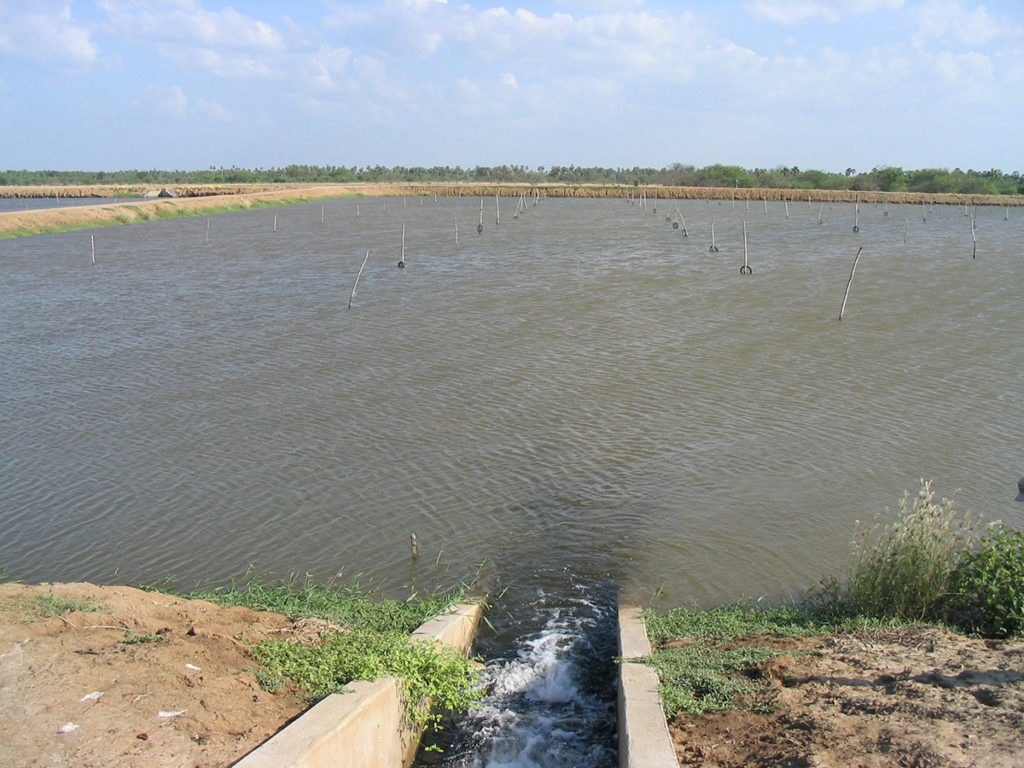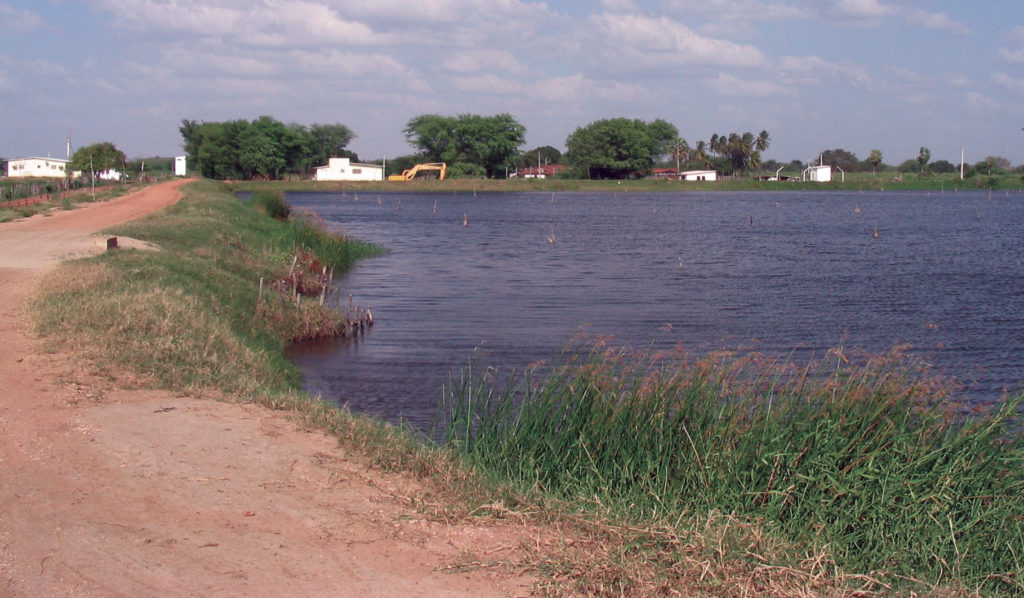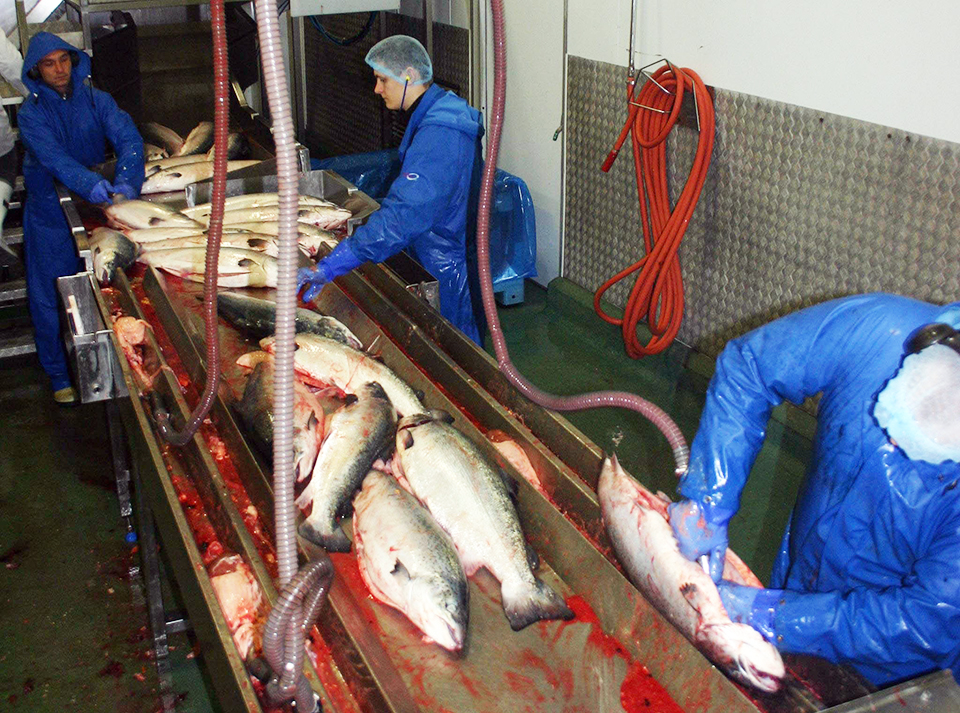Ionic imbalances can cause aberrations in pH or other water quality variables

The saline ground water often used in inland, low-salinity culture of marine shrimp and other species frequently is deficient in potassium, magnesium, and other ions. Since the application of potassium and magnesium salts to correct ionic imbalances has caused striking improvements in survival and production, the practice is becoming increasingly common.
For example, an inland shrimp farm in Alabama, USA, with pond water salinity of 2 to 4 ppt and potassium and magnesium concentrations below 10 milligrams per liter reported survival of 19 percent and production of 595 kilograms per hectare in 2001. In 2002, mineral salts were applied to raise potassium concentrations to 35 to 40 milligrams per liter and magnesium concentrations to about 20 milligrams per liter. Survival improved to 67 percent and production averaged 4,068 kilograms per hectare in 2002.
Ionic imbalances can also have adverse effects on fish in freshwater. Sometimes ionic concentrations are too low to support normal osmoregulatory processes in culture species. In other cases, ionic imbalances cause aberrations in pH or other water quality variables.
Moreover, in channel catfish farming, sodium chloride is applied to ponds to increase chloride concentration and reduce the possibility of nitrite absorption by fish. This treatment has been highly successful in combating nitrite toxicity.
Mineral use
Many mineral salts are used in aquaculture. The most common are chemical fertilizers and liming materials. Nitrogen, phosphorus, potassium, and other nutrients are supplied by chemical fertilizers to promote phytoplankton growth. Also, sodium metasilicate is applied to brackishwater ponds to increase silicate concentrations and enhance diatom abundance.
Liming materials neutralize the acidity and increase the pH of bottom soil and water, and increase alkalinity and hardness in water. Liming materials are not highly soluble and normally do not increase total alkalinity and total hardness above 75-100 milligrams per liter. Thus, they effect only small increases in bicarbonate, calcium, and magnesium concentrations and normally are not used to correct ionic imbalances.
Highly soluble in freshwater and brackishwater, sodium bicarbonate can be used to increase bicarbonate levels and alkalinity. However, under most circumstances, it is more cost-effective to use traditional liming materials for this purpose.
Calcium sulfate
Calcium sulfate also is known as gypsum or agricultural gypsum. This mineral is mined from deposits in arid regions. It also is a byproduct of phosphate fertilizer manufacturing. The mined product usually contains 95 percent or more calcium sulfate, while the byproduct usually has a content of about 80 percent.
Gypsum applications can increase the concentrations of calcium, the calcium part of total hardness, and sulfate levels. Assuming the gypsum is 95 percent pure, 1 grams per cubic meter would cause the following increases in water quality variables: calcium, 0.22 milligrams per liter; total hardness or calcium hardness, 0.55 milligrams per liter; and sulfate, 0.53 milligrams per liter. Gypsum’s limited solubility decreases with increasing salinity. However, it can be useful in increasing calcium concentrations to 100 to 150 milligrams per liter (250-375 milligrams per liter calcium hardness).
Muriate of potash
Muriate of potash is available as a fertilizer-grade material which consists primarily of potassium chloride. The product usually has a potassium oxide equivalence of 60 percent and contains about 49.8 percent potassium and 45.2 percent chloride.
Muriate of potash has two major advantages as a source of potassium: high water solubility and relatively low cost. Each grams per cubic meter of fertilizer-grade muriate of potash will increase potassium concentration by 0.5 milligrams per liter and chloride concentration by 0.45 milligrams per liter. When used as a fertilizer, treatment rates usually are selected to increase potassium concentrations by 0.5 to 1.0 milligrams per liter. Much larger doses are needed to increase low potassium concentrations in saline water.
Potassium and magnesium sulfates
Potassium magnesium sulfate is an interesting product because it contains two ions, potassium and magnesium, which have frequently been associated with ionic imbalances in saline water for inland culture of marine organisms. One commercial potassium magnesium sulfate salt contains 17.8 percent potassium, 10.5 percent magnesium, and 63.6 percent sulfate. The product is soluble in freshwater or brackishwater, but does not dissolve as rapidly as muriate of potash. The fertilizer-grade material is not extremely expensive. Its application at 1 grams per cubic meter provides about 0.18 milligrams per liter potassium, 0.1 milligrams per liter magnesium, and 0.64 milligrams per liter sulfate.
Potassium sulfate also is available in fertilizer grade with about 41.5 percent potassium and 50.9 percent sulfate. It is highly soluble in water and modest in cost. Application of 1 grams per cubic meter of potassium sulfate increases potassium and sulfate concentrations by 0.42 milligrams per liter and 0.51 milligrams per liter, respectively.
Magnesium sulfate often is put in fertilizers as a source of the secondary nutrients magnesium and sulfate. The most common fertilizer-grade material is magnesium sulfate heptahydrate, or Epsom salt, which contains about 10 percent magnesium and 0.39 percent sulfate. When applied to water at 1 grams per cubic meter, the increase in magnesium concentration will be 0.1 milligrams per liter, and sulfate concentration will increase by 0.39 milligrams per liter.
Sodium chloride
Industrial-grade, mine-run sodium chloride (salt) commonly is used in freshwater aquaculture to increase chloride concentrations and counteract nitrite toxicity to fish. It also can be used to increase salinity concentrations.
This product is highly water soluble and contains 98 to 99 percent sodium chloride. At an application rate of 1 grams per cubic meter, the increase in water quality variables is 0.39 milligrams per liter sodium, 0.61 milligrams per liter chloride, and 0.98 milligrams per liter (0.00098 ppt) salinity.
Concentrations needed
There is no definitive data on the concentrations of ions needed for the culture of most species. However, a report by Boyd, Thunjai and Boonyaratpalin in the June 2002 Global Aquaculture Advocate suggested that for the culture of marine species in low-salinity water, the concentrations of ions should be similar to those in normal seawater diluted to the same salinity as the water of the culture system. Factors for estimating these concentrations are provided in Table 1.
Boyd, Factors that can be multiplied by salinity (ppt) to give acceptable concentrations of ions, Table 1
| Ion | Factor |
|---|
Ion | Factor |
|---|---|
| Calcium | 11.6 |
| Magnesium | 39.1 |
| Potassium2 | 10.7 |
| Sodium | 304.5 |
| Chloride | 551 |
| Sulfate | 78.3 |
1 Total alkalinity should exceed 75 mg/l as CaCO3.
2 Example: For a water with 3.5 ppt salinity, water potassium concentration should equal 10.7 x 3.5 or 37.4 milligrams per liter.
Water in aquaculture ponds should have at least 75 milligrams per liter total alkalinity (91 milligrams per liter bicarbonate). Moreover, the concentrations of calcium, magnesium, and potassium are critical because these ions have specific physiological functions. The other ions – sodium, chloride, and sulfate – contribute to salinity and osmotic pressure. Thus their proportions are probably less important than those of calcium, magnesium, and potassium.
To calculate the dose rate of mineral salt to give a desired concentration, use the following equation:

For example, to use muriate of potash to increase potassium concentration by 25 milligrams per liter: Dose of muriate of potash = 25 mg potassium per liter = 50 percent potassium per 100 = 50 milligrams per liter.
Distribution
Although mineral salts are water-soluble, they provide better results when broadcast over ponds in front of mechanical aerators or premixed with water and splashed over pond surfaces. Since the ions are not highly reactive with soil, major losses of salt ions occur primarily through seepage, overflow and intentional discharge of water for harvest.
(Editor’s Note: This article was originally published in the August 2003 print edition of the Global Aquaculture Advocate.)
Now that you've reached the end of the article ...
… please consider supporting GSA’s mission to advance responsible seafood practices through education, advocacy and third-party assurances. The Advocate aims to document the evolution of responsible seafood practices and share the expansive knowledge of our vast network of contributors.
By becoming a Global Seafood Alliance member, you’re ensuring that all of the pre-competitive work we do through member benefits, resources and events can continue. Individual membership costs just $50 a year.
Not a GSA member? Join us.
Author
-

Claude E. Boyd, Ph.D.
Professor, Department of Fisheries and Allied Aquacultures
Auburn University
Auburn, Alabama 36849 USA
Tagged With
Related Posts

Responsibility
Revisiting ionic imbalance in low-salinity shrimp aquaculture
Ionic imbalance in low-salinity culture water may negatively influence shrimp survival and growth, and it is common to apply various mineral salts to low-salinity shrimp ponds.

Responsibility
Salinity balance key to culture success
Outside optimal salinity ranges, aquaculture species have higher feed-conversion ratios, grow at slower rates, become stressed and susceptible to disease, or even die.

Responsibility
Water composition: Dissolved inorganic solids
A few anions and cations, and un-dissociated silicic acid represent the largest fraction of dissolved inorganic solids in water. The total concentration of ions is called the salinity. The total dissolved-solids concentration usually is roughly equal to salinity in freshwater. Unlike seawater, freshwater varies greatly in salinity and proportions of individual ions. Calcium and bicarbonate are dominant ions in river water, but sodium and chloride are dominant in seawater. Water contains many other inorganic substances, as well as many trace elements.

Responsibility
Aquaculture byproducts improve sustainability of seafood value chains
Tons of aquaculture byproducts are available as sources for fishmeal and fish oil to supplement the supplies obtained from fisheries. Innovative technologies are supporting more efficient use of these by-products in aquafeed.

